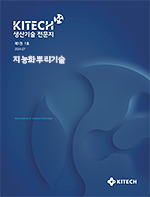저자 소개
We aim to find a solution to emerging the environmental issues through
- Rational design and fabrication of functional nanofiber-based membrane with desired properties and structure.
- Recycling and upcycling of synthetic polymer via physical/chemical treatment.
- Understating properties and behaviors of natural polymers for broadening its application and replacing synthetic polymers.
- Development of membrane-based filtration system for environmental remediation.
- Development of polymeric material for resource recovery.
학력 / 경력 정보
- 2004-2009한양대학교 이학사
- 2009-2015한양대학교 박사
활동내역
-
논문
Optimizing Cellulose Acetate Microbead Formation through Premixed Membrane Emulsification: Unraveling Critical Parameters, Carbohydrate Polymers Technologies and Applications, 2024, 8, 100545
논문
Fabrication of composite microbeads consisting of cellulose and covalent organic nanosheets via electrospray process, Cellulose, 2024, 31, 2281-2293
상세 보기
- KITECH 생산기술 전문지 > 인간중심생산기술
- Volume 2(4); 2025
- Article
인간중심생산기술 2025;2(4):138-142. Published online: Oct, 1, 2025
용매추출에 의한 분리 및 회수 방법으로 습식 제련에 의한 폐리튬이온전지 (LiB) 재활용 기술
-
* 한국생산기술연구원 인간중심생산기술연구소 안전융합기술연구부문 / 수석연구원(보) / hoik@kitech.re.kr / 교신저자
초록
폐리튬 이온 배터리에 유가금속 (Li, Ni, Co, Mn)이 함유되어 있다. 일반적으로 폐LIB에는 코발트 5~20wt.%, 리튬 5~7wt.%, 니켈 5~7wt.%, 유기물 15wt.% 및 플라스틱 7wt.%가 함유되어 있으며 조성은 제품에 따라 조금씩 다르다. 금속 함량이 일반적으로 천연 광석보다 훨씬 높으며 또한 코발트와 니켈 및 리튬은 희소금속으로 중요한 전략적 금속으로 취급하고 있다. 하지만, 폐리튬이온전지르 단순 처리하거나 매립 등 부적합한 처리 방법으로 처리할 경우 누출된 유해 물질로 인해 토양 및 지하수 오염 등 심각한 환경오염이 발생할 수 있다. 따라서, 폐리튬 이온 배터리의 재활용은 자원절약 및 환경보호의 관점에서 필요하다 [4]. 이에 따라, 폐리튬 이온 배터리에서 재활용을 위한 요소 기술인 습식 공정이 있다. 그 중, 용매추출(Solvent extraction)에 의한 분리 및 회수 공정에 관해 폐리튬 이온 배터리의 습식제련 재활용 방법과 그 환경 영향을 최소화할 수 있는 개발 가능성을 소개하고자 한다.
키워드 리튬이온전지, 베터리, 재활용, 습식공정, 용매추출









댓글0